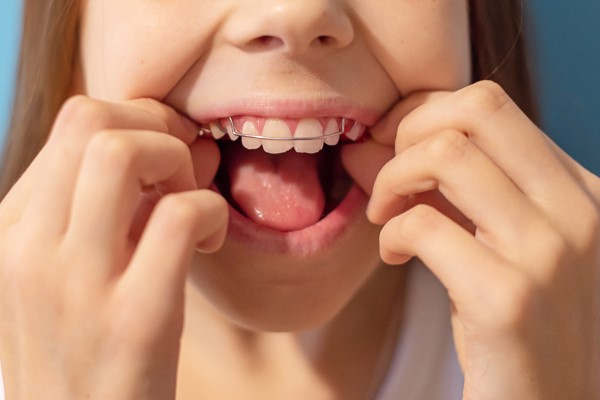



An orthodontist can help you deal with a wide range of orthodontic issues. For example, poorly aligned teeth can often lead to problems like difficulty chewing food and problems with speech. A bad bite can also increase a person’s risk of developing issues like teeth grinding.
Straightening a person’s teeth improves the appearance of their smile and the functionality of their teeth. Fixing teeth alignment issues also protects teeth against tooth decay and gum disease because it makes it easier to clean their surfaces.
How an orthodontist helps improve your bite
Properly aligned teeth tend to be more durable than poorly aligned ones. This is due to poorly aligned teeth being positioned at awkward angles, which can stress uneven bite forces while grinding food.
Straightening a person’s teeth makes it easier for them to exert even pressure on their teeth as they chew food, and it helps with their speech. For example, teeth are used to pronounce sounds like “T,” and misaligned teeth can make such pronunciations more challenging. The most common bite issues that orthodontists deal with include:
Crossbite: This occurs when a person’s teeth overlap unevenly when the mouth is closed. Some top teeth might correctly overlap the lower teeth, but others do not extend far enough. The condition increases the risk of teeth becoming chipped or fractured.
Open bite: This occurs when a person’s front teeth do not overlap the bottom set of teeth as they should. The top and bottom teeth might not even touch when the mouth is closed. Open bites are believed to be caused by habits like thumb sucking or thrusting when young. The condition puts excessive stress on the patient’s molars, increasing the risk of them becoming damaged.
Overbite: This refers to a patient’s upper set of teeth sticking out farther than their lower set. It tends to wear out the front teeth, and people with the condition often accidentally bite into their gum tissue.
Underbite: This is when the lower set of teeth stick out farther than the upper set. It leads to issues like difficulty chewing and excessive stress placed on the temporomandibular joints.
Early detection of bite issues often leads to more effective treatment. Orthodontists recommend bringing in children for their first bite evaluation by the time they reach seven. Many of these problems can be detected at this age, and a child’s jaw and facial structures are still developing, making it easier to correct issues with their bite.
Orthodontic devices like braces are often recommended for fixing bite issues. If the patient requires surgical orthodontics, the orthodontist might wait until they are around 18 to perform the procedure. Treatments that an orthodontist might recommend to help correct a patient's bite include the following.
1. Braces
Braces are one of the oldest ways to straighten teeth. They work by gradually pushing teeth toward a better alignment. Braces have two primary parts: metal brackets that an orthodontist glues to each of the patient's teeth and wires that link all the brackets on each dental arch. The tighter these wires are, the more force the appliance exerts on the patient's teeth.
Braces are permanently fixed in place once installed by an orthodontist. Treatment times are typically somewhere around 12 to 36 months.
Braces can be used to treat most bite issues, including those caused by abnormal jaw positioning. Metal braces are known for their poor aesthetics, but subtler alternatives, like ceramic braces, are available.
2. Clear aligners
Clear aligners have been around for a few decades and provide a subtler and more convenient way to straighten teeth. Treatment with these appliances involves wearing removable, rigid plastic trays for up to 22 hours a day. These trays are virtually invisible when worn, enabling wearers to show off their smiles as their teeth alignment improves.
Treatment involves using several sets of aligner trays for up to two years. Each set of aligner trays is worn for roughly two weeks before being swapped with another set that continues the alignment process. The patient's teeth should be properly aligned when they finish using all their aligner trays.
Treat your bite problems
Our orthodontist and team members have dedicated themselves to doing all that they can to address your bite and teeth alignment issues. Give us a call or stop by our Reston clinic to set up an appointment.
Request an appointment here: https://www.orthodonticprecision.com or call Precision Orthodontics & Pediatric Dentistry at (703) 391-8800 for an appointment in our Reston office.
Check out what others are saying about our dental services on Yelp: Orthodontics in Reston, VA.
Recent Posts
Wearing braces gives you a lot to think about leading up to and during the treatment. The process can be successful and produce the results you want. Whether you have crooked teeth, bite problems, or a crowded mouth, you can soon have a new smile. However, there are some important guidelines to follow during this…
Metal braces have been used to straighten teeth for over a century and remain an efficient way to straighten teeth. These oral appliances work by applying constant pressure on your teeth, slowly improving their alignment over 12 to 36 months. The appliance is fixed in your mouth after a dentist installs it, and it stays…
Like braces, clear aligner treatment can successfully straighten teeth and correct bite problems. Braces were the most popular and available choice for many years, but aligners are more common today than ever. If you are unhappy with the way your smile looks, aligners can be effective. Understanding how aligners work and what the process is…
As you prepare to get braces and start wearing them, you may be a little nervous. It can take some time to get used to this treatment. You will encounter some challenges, but the result can help you achieve your goals. During the process, you need to be diligent about caring for your braces. This…


